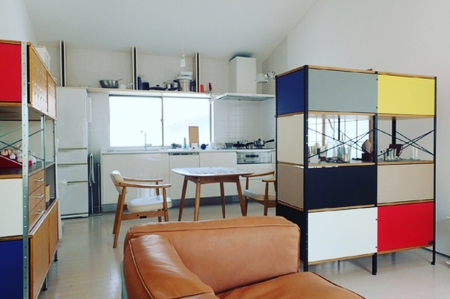様々な寄せ集め
壁が梃子の支点の役割をするように、村上春樹の「梃子」の話が頭から離れない、それを今、自分が考えている空間に当て嵌めると、どうなるか。
空間がそこにいる人しだいで見え方が変われば、それが人と建築の関係性においては良いことだろうと考えていて、それも人の気分しだいで、何か作用して見え方が変われば良い、壁を梃子にして、気分という推進力を得て、建築を増幅させる。
そう考えていると、空間は様々な物が寄せ集まってできているが、ずっと前から、建築を学びはじめた頃から、空間は実体があるけれど、目で見ることはできず、感じることしかできない、空気のような存在だと、何故か思っていて、そうなると、空間自体にはあまり興味が無く、その様々な物が寄せ集まってできている状態に興味が湧くのだと改めて思った。
だから、建築の中にある物、全てに興味があり、家具、食器やカトラリー 、調理道具などなど、それらも建築の範疇だと考えている。
ただ、例えば、住宅ならば、自邸はともかく、住人がいて、設計者がいる、という関係性の中で、どこまで関わることができるかという想いが常にあり、全てをコントロールをしたいと思いつつ、それでは、何か予想外のことが起こらないからつまらない、という想いもあり、それでどうするかが設計の際の常に中心にある考えのひとつだった。
"Various collections"
Just as the wall plays the role of a lever, the story of Haruki Murakami's "Lever" will not be left out of my mind.
I think that if the appearance changes depending on the people in the space, it will be a good thing in the relationship between people and architecture, and if that also depends on the mood of the person, if something acts and the appearance changes Good, leverage the walls, get the driving force of mood and amplify the architecture.
If you think so, the space is made up of various things, but since long ago when you started studying architecture, the space has substance, but you can not see it with your eyes, you can only feel For some reason, I thought that it was impossible, like an air, and I realized again that I was not interested in the space itself, and that I was interested in the state that various things gathered together.
Therefore, I am interested in everything in the architecture, including furniture, tableware, cutlery, cooking utensils, etc., and consider them to be in the category of architecture.
However, for example, if it is a house, there is always a feeling of how much you can be involved in the relationship that there is a resident, a designer, aside from your own residence, and you want to control everything, There was also the idea that something unexpected was boring because nothing unexpected happened, and what to do with it was one of the always central ideas in design.

